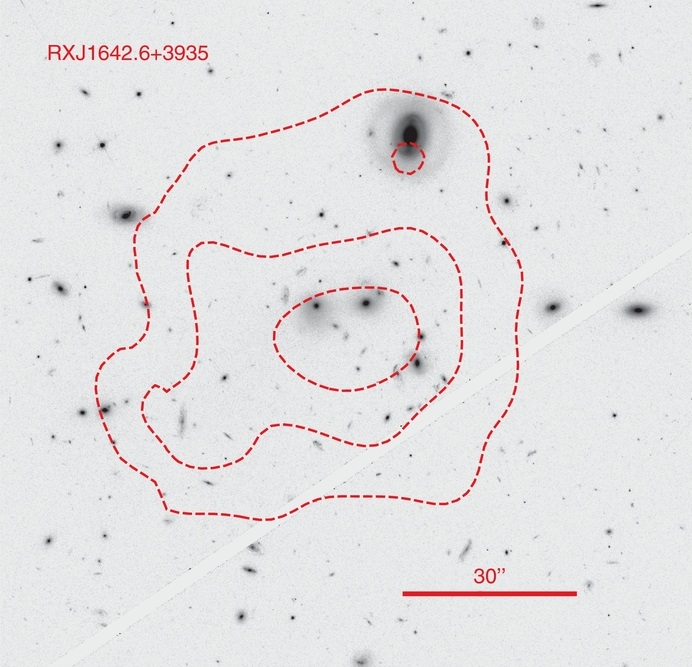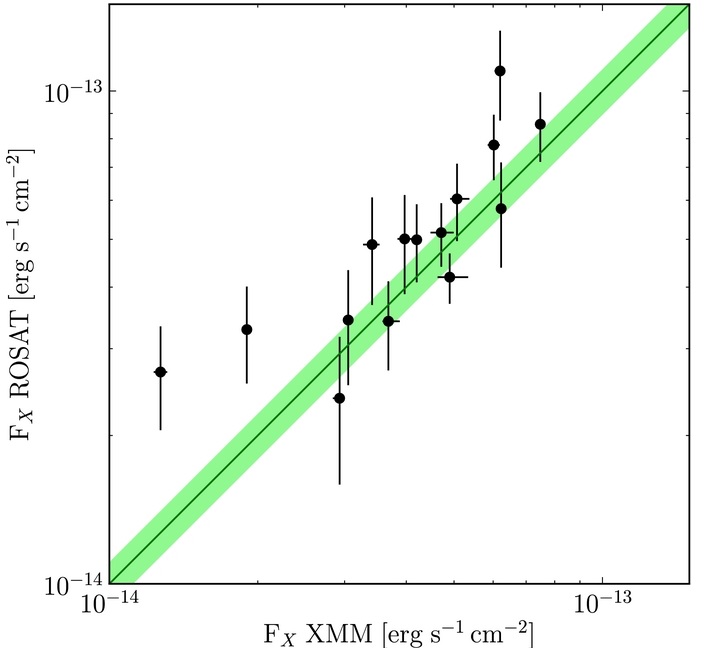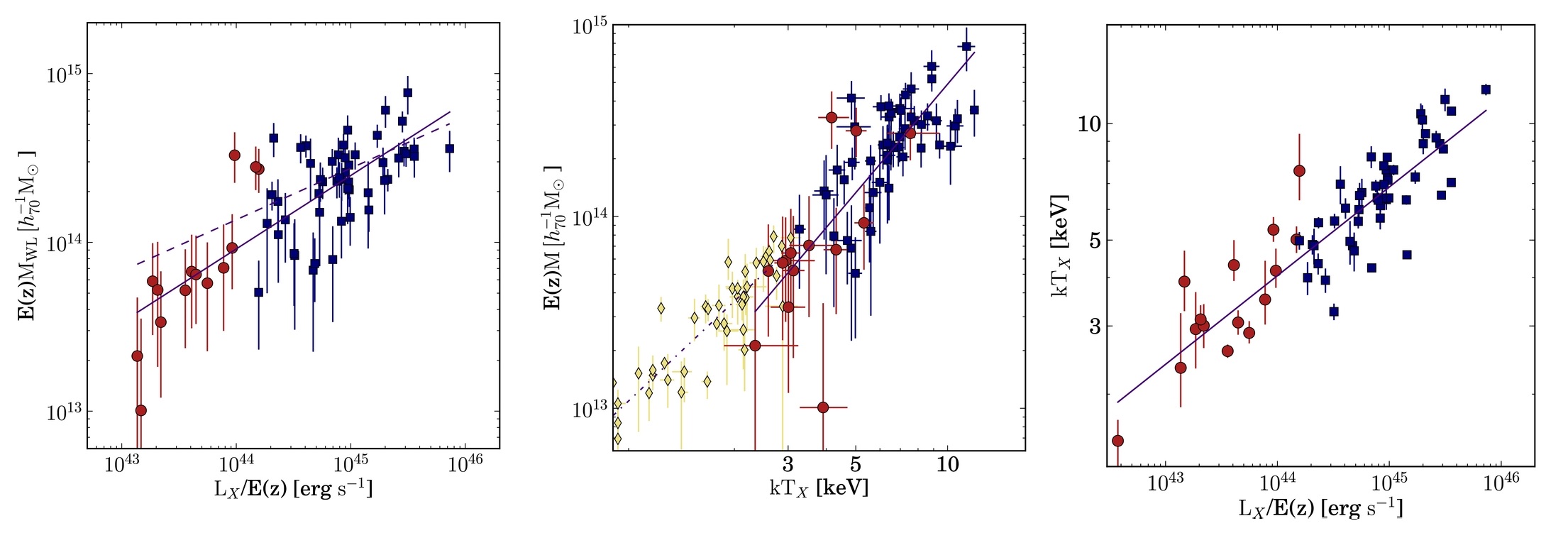What Separates Groups from Clusters
Relevant Works: Connor et al., 2014;
What is the difference between a galaxy group and a galaxy cluster? The simple answer is clusters have more galaxies. But is that it? Are groups just scaled-down versions of clusters? Specifcally, can we take what we know about clusters, project to lower halo masses, and get reasonable answers for the properties of groups? Or is there something fundamentally different between the two -- and, if so, where do we draw a line separating groups and clusters?
One way to approach this problem is to examine the scaling relations between observable properties of groups and clusters -- things like their mass, gas temperature, and X-ray luminosity. Kaiser (1986) first showed that these relations could be cast analytically for the case of cold gas falling onto pre-existing dark matter structures. Modifications by Kaiser (1991) and Evrard & Henry (1991), which preheated gas to increase the entropy, produced results fairly consistent with observations of clusters. However, Ponman et al. (1996), Xue et al. (2000), and others have shown that these scaling relations break around the transition to groups. While there is disagreement about the magnitude -- or even presence -- of this effect (e.g., Sun et al. 2009), it provides a compelling marker of the difference between groups and clusters.
 We set out to obtain a deeper insight into the nature of changes
to scaling relations by studying 25 groups with weak lensing masses.
As these scaling relations are most useful when we can compare them
to meaningful quantities, a sample with accurate masses is very useful.
The 25 groups, first presented by
Hoekstra
et al. (2011), cover 0.3 < z < 0.6, and are therefore at
intermediate redshifts. The Hoekstra paper included scaling relations for
X-ray properties, but those used ROSAT values from the 160SD Survey
(Vikhlinin
et al., 1998). We advanced this sample one step forward -- combining
the excellent weak lensing masses with much better X-ray data from
XMM-Newton. An example of one of these clusters is shown in the figure
to the right: X-ray contours are shown in red, while the galaxy distribution
as imaged by HST is shown in black.
We set out to obtain a deeper insight into the nature of changes
to scaling relations by studying 25 groups with weak lensing masses.
As these scaling relations are most useful when we can compare them
to meaningful quantities, a sample with accurate masses is very useful.
The 25 groups, first presented by
Hoekstra
et al. (2011), cover 0.3 < z < 0.6, and are therefore at
intermediate redshifts. The Hoekstra paper included scaling relations for
X-ray properties, but those used ROSAT values from the 160SD Survey
(Vikhlinin
et al., 1998). We advanced this sample one step forward -- combining
the excellent weak lensing masses with much better X-ray data from
XMM-Newton. An example of one of these clusters is shown in the figure
to the right: X-ray contours are shown in red, while the galaxy distribution
as imaged by HST is shown in black.
 The first thing we found was that the XMM values were not going to be
good enough. They were based on flux measurements but, as we show in
the figure to the right, these were generally all too small -- thereby
biasing the X-ray luminosity to be too low, as well. In addition, the
flux values were for infinite apertures, whereas the mass measurements
were to specific cluster radii -- combining the two is a recipe for bad
science. The properties within the Δ=2500 and Δ=500 radii
are not the same (see also, e.g., Czakon
et al., 2015).
The first thing we found was that the XMM values were not going to be
good enough. They were based on flux measurements but, as we show in
the figure to the right, these were generally all too small -- thereby
biasing the X-ray luminosity to be too low, as well. In addition, the
flux values were for infinite apertures, whereas the mass measurements
were to specific cluster radii -- combining the two is a recipe for bad
science. The properties within the Δ=2500 and Δ=500 radii
are not the same (see also, e.g., Czakon
et al., 2015).
 Using a well-matched cluster sample in a similar redshift from Mahdavi
et al. (2013) and some groups from Sun
et al. (2009), we calculated scaling relations for three properties:
mass, X-ray luminosity, and X-ray temperature. The observed scaline
relations are shown to the left. In all three cases, we found no
evidence for there being a break in the scaling relations from clusters
down to our sample.
Using a well-matched cluster sample in a similar redshift from Mahdavi
et al. (2013) and some groups from Sun
et al. (2009), we calculated scaling relations for three properties:
mass, X-ray luminosity, and X-ray temperature. The observed scaline
relations are shown to the left. In all three cases, we found no
evidence for there being a break in the scaling relations from clusters
down to our sample.
So what does this mean? Well, a break in the scaling relations generally means that the physics of gravitationally-dominated cluster assembly are not enough to explain the circumstances of groups. In other words, the energy budget is no longer dominated by gravitational potential alone, but now astrophysical processes are more important. As we did not see a break, the implication is that the effects of e.g. AGN and supernovae have not had a significant impact on the gaseous properties in the inner radii of clusters in this mass range and at these times. Smaller clusters, or the same clusters with more time to evolve, may still demonstrate a break. Future study, both of these groups and of the rest of the 160SD sample, is still warranted.